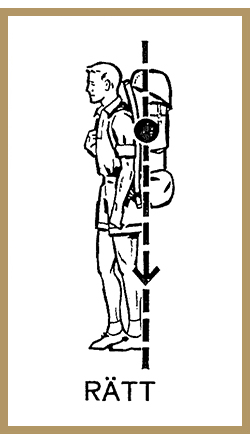History 歷史



A supporting idea 支撐構想

Reindeer herder Nils Olsson Sarri, now 80 years old, still remembers how impressed he was by a new backpack frame in the 1950s. The frame had been made by a 14-year-old boy named Åke Nordin.
Åke had made the backpack before heading off on a trip to Dikanäs, a small community in the Västerbottensfjällen mountains, in the summer of 1950. At that time, most backpacks looked like shapeless pears. With a full backpack on their backs, hikers had to be bent nearly double in order to stop themselves from falling backwards because of the weight. Having a heavy sack resting directly on the back also meant that shirts became drenched with sweat, and this meant hikers could easily get chilly if the weather changed. The young Nordin decided to do something about this problem.
He had read that if you were going to carry something heavy, the weight should be positioned high up and close to the back. While his friend, Lars-Olof, was tying fly fishing knots, Åke went out to the barn outside the Nordin family"s summer cottage on Ulvön and hammered together a wooden frame. Åke"s mum, Gunhild, was a the daughter of a tailor and had taught Åke how to sew already when he was 10 years old. Using her Singer treadle sewing machine, he sewed a sack in a strong cotton fabric which he attached to the wooden frame with leather straps. He fashioned the shoulder straps out of calfskin ribbons. The backpack was comfortable to carry. The ladder-shaped carry frame distributed the load better across the back and improved ventilation between the back and the backpack. In addition, he could carry a heavier load. Åke filled the backpack with the tent and enough food for both himself and his travel companion. Soon, they were on the postbus heading north.
In the mountains the backpack attracted a lot of attention. Particularly among the Sami, who spent weeks at a time up on the mountains. They understood the importance of a robust backpack that was still comfortable when you were carrying a heavy load. One of the Sami asked Åke to make him a backpack. The next time he visited the mountains the news about his backpack had spread among the other reindeer herders. Over the next few years, an idea started to take shape in the young Åke Nordin"s mind about starting a business making modern equipment that would make life easier when spending time in the wilderness.
Like his father, fruit dealer Karl-Erik Nordin, before him, Åke attended the educational association, Bröderna Påhlmans Commercial College, in Stockholm. He then did 15 months of military service at the newly established and extremely demanding Paratrooper School in Karlsborg, where Åke became even more convinced that there was a market for functional and hard-wearing outdoor equipment. He felt that not even the equipment used by the most elite unit in the country made the grade.
Ten years after Åke had put together his first backpack as a young boy, more precisely in May 1960, issue number 4 of the Swedish Tourist Association"s Newspaper dropped through the letterboxes of the association"s members all over Sweden. Crammed in next to an advert for Jukon"s ointment for haemorrhoids, readers could find a brief advert for a new type of backpack from the newly established company Fjällräven. "LIGHTWEIGHT carry frame, tested during three years of winter and summer mountain treks", stated the advert, adding: "If you know a Sami or a mountain farmer, ask him how you should carry a really heavy backpack. He will tell you about the unsurpassable carrying properties of the carry frame." The small black and white photos, the size of a stamp, show a young man with military posture, carrying an enormous backpack on his back. The man in the picture is Åke Nordin.
現年80歲的馴鹿牧人Nils Olsson Sarri依然記得1950年代時,有一套新的背囊框架讓他驚艷不已,這套框架是一位叫做Åke Nordin的14歲小男孩所設計出來的。



